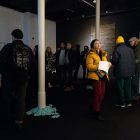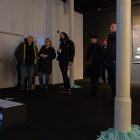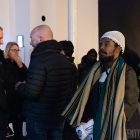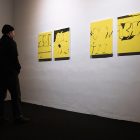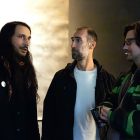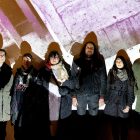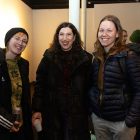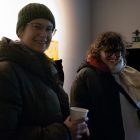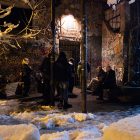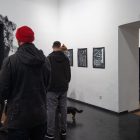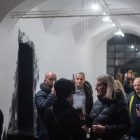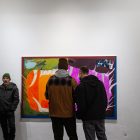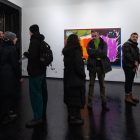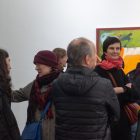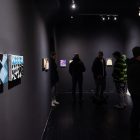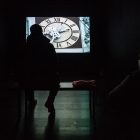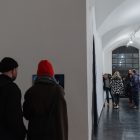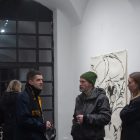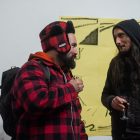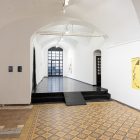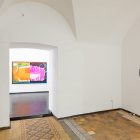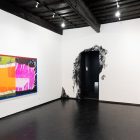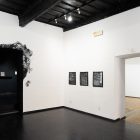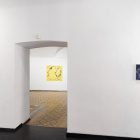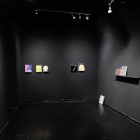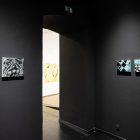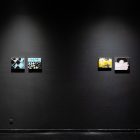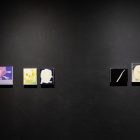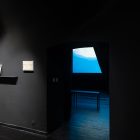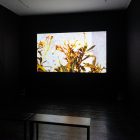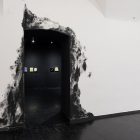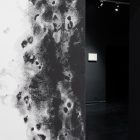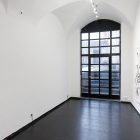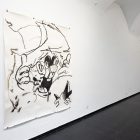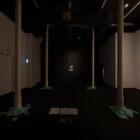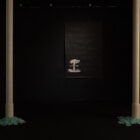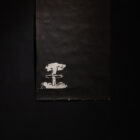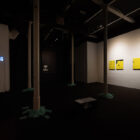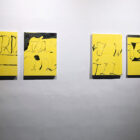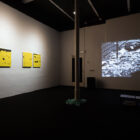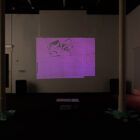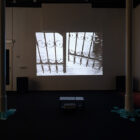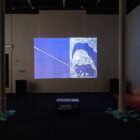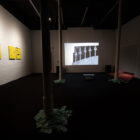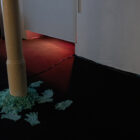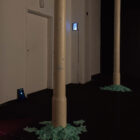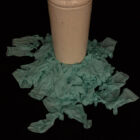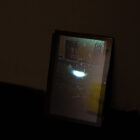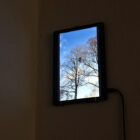Solo exhibitions
Jaka Vatovec: False Magic 9
19 January – 7 February 2024
Alkatraz Gallery, AKC Metelkova, Masarykova 24, Ljubljana
Opening: Friday, 19 January, 6 pm
Jaka Vatovec: False Magic 3
19 January – 15 February 2024
Škuc Gallery, Stari trg 21, Ljubljana
Opening: Friday, 19 January, 8 pm
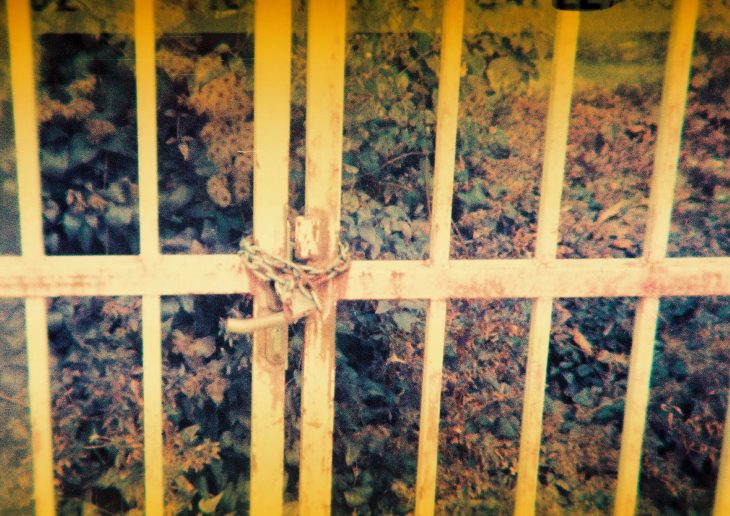
The solo exhibitions by artist Jaka Vatovec False Magic 3 at Škuc Gallery (19. 1.–15. 2. 2024) and False Magic 9 at Alkatraz Gallery (19. 1.–7. 2. 2024) are a part of the False Magic project, which is co-produced by ŠKUC Association, KUD Mreža and SCCA-Ljubljana. Vatovec’s latest art production uses metaphor to explore life with obsessive-compulsive disorder. Our attention is directed towards the connection we establish with both the artistic material and the personal confessions that we intentionally keep hidden. The collaboration between local NGOs is a considerate effort that removes the transient shock of challenging narratives, allowing us to approach with discernment. Teaching, raising awareness and advocating with understanding and compassion are increasingly becoming key aspects of curatorship and art-making, all the more important within the precarious frameworks of contemporary art production in which we are entangled as cultural producers (cultural workers, artists, writers, curators, etc.).
EXHIBITION EVENTS
Viewing of the exhibition with the artist and curators
Friday, 2 February:
- False Magic 9 at 6 pm at Alkatraz Gallery
- False Magic 3 at 7 pm at Škuc Gallery
Jaka Vatovec: False Magic 3
19 January – 15 February 2024
Škuc Gallery, Stari trg 21, Ljubljana
Opening: Friday, 19 January, 8 pm
Curators: Tia Čiček, Lara Plavčak
__________
False Magic connects the exhibitions at Škuc Gallery (False Magic 3, 19. 1.–15. 2. 2024) and Alkatraz Gallery (False Magic 9, 19. 1.–7. 2. 2024). Key concerns about the project were founded on how to address the new production, which presents insights into life with obsessive-compulsive disorder (OCD). The artists’ personal stories remain an essential source for the interpretation of the artworks, while the voyeuristic insight can archetypalise their lives as either romanticised or undesirable (e.g. the tortured artist genius). The project and the two exhibitions do not aim to educate the public and/or present life with OCD, but rather to confront the artistic material, which stands as a metaphor for the first-person narrative of the experience of the disorder.
In her essay at the end of the 1970s,[1] Susan Sontag spoke out against the use of illness as a metaphor. To understand a person’s illness as a metaphor (e.g. as a punishment from God, as the result of unexpressed energy) is not only untrue but also punitive. When used metaphorically to explain society and other phenomena, the illness itself loses its gravity and becomes increasingly abstract. By appropriating metaphors, Jaka Vatovec, on the other hand, invents a visual language that is neither diagnostic nor superficial and in which he can talk about his experiences with OCD. The clock/saw can be read as a symbol for neurodivergent time (under the umbrella term crip time).[2] Either lost or, in the eyes of society, unproductive and irredeemable. Pockets of time are filled by compulsions/rituals that provide temporary relief, but obsessions/intrusive thoughts also demand their time and spread uncontrollably like mould.
Obsessive-compulsive disorder (OCD) is an anxiety disorder characterised by distressing, repetitive and intrusive thoughts, apprehension, fear or anxiety, and repetitive behaviour in the form of compulsions (aka rituals) designed to alleviate the associated anxiety. The increasing testimonies on mental health in social media have helped to expand the understanding of illnesses, disorders and disabilities from the purely symptomatic (external medical regard) to the experiential (first-person narrative).[3]
Destigmatisation of mental disorders is necessary, but it can quickly lead to trivialisation, which in turn hinders a true understanding of the experiences and needs of those affected. This is exactly what has happened with OCD – because it is generalised in popular culture as an eccentric personality trait or stereotype, such as obsessive hand hygiene or manic tidying up that can lead to a misunderstanding of the severity of the disorder and its impact on the individual’s everyday life. “Therefore, while the individual continues to be stigmatized by virtue of their status as “mentally ill,” their disorder is depathologized.”[4] By misrepresenting OCD, those in a privileged position (i.e. without mental illness) rob people with actual OCD of an essential hermeneutic tool for communicating the nature of their experience.
“Refusal, and stances of refusal in research are attempts to place limits on conquest and the colonisation of knowledge by marking what is off limits, what is not up for grabs or discussion, what is sacred, and what can’t be known.”[5]
With this consideration, the researchers refrain from passing on certain stories that have been entrusted to them. They deliberately omit to shed light on certain aspects of traumatic events, even though they could help the affected communities by raising awareness and advocacy. Indeed, Tuck and Yang note that much of the work within academic structures simply reproduces stories of oppression.[6] In this way, the material studied is given significance, but the power relations remain unequal – and the academic voice uses the content to validate its own existence. Such tendencies to re-evaluate the mediation of marginalised stories can also be seen in the treatment of artistic material. In curatorial work and artistic production, we question the power positions and backgrounds of the speakers and become more sensitive to the nature of the narrative and the context, not just the information/content that can be obtained.
We understand what can be told and then not shared. Neoliberal currents in both the sciences and the arts prioritise the telling of difficult stories of vulnerable groups and individuals in order to draw attention to human injustice and the possibility of redress. We want stories and works that shake us up, move us and almost force us to pause and reflect. In this project, we try neither to shock nor to lecture, and invite you to reflect. The aim of the project is to take the momentary reactivity away from difficult, hidden stories so that we can approach them with discernment. Education, awareness-raising and advocacy for understanding and compassion are becoming increasingly important aspects of curating itself and of art-making, all the more important in the precarious contexts in which we cultural producers (cultural workers, artists, writers, curators, etc.) are trapped.
Tia Čiček in Lara Plavčak
__________
[1] Sontag, Susan. 1978. Illness as Metaphor. New York: Farrar, Straus and Giroux.
[2] Crip time, , see Alison Kafer. Non-linear time (and space) experienced by disabled people. Crip comes from cripple, and both words have been re-appropriated by some disabled people and groups as an act of empowerment and destigmatisation. The word can be use by non-disabled people with explicit consent if it refers to an individual or a specific group. In: Aplinc, Urška and Plavčak, Lara. 2023. Sick (21. 6.–18. 7. 2023, Škuc Gallery) [https://www.galerijaskuc.si/exhibition/sick/].
[3] It is worth noting that activists in the field of Disability Studies and Mad Studies view OCD as a form of neurodivergence not as a disorder or illness, but as a disability.
[4] Spencer, Lucienne and Carel, Havi. 2021. ‘Isn’t Everyone a Little OCD?’ In: The Epistemic Harms of Wrongful Depathologization. Philosophy of Medicine Vol. 2 No. 1, p. 14.
[5] Tuck, Eve and Yang, K. Wayne. 2014. R-Words: Refusing Research. In: Humanizing Research: Decolonizing Qualitative Inquiry with Youth and Communities, London: Sage, p. 225.
[6] Ibid, p. 227.
Jaka Vatovec: False Magic 9
19 January – 7 February 2024
Alkatraz Gallery, AKC Metelkova, Masarykova 24, Ljubljana
Opening: Friday, 19 January, 6 pm
Curators: Vesna Bukovec, Anabel Černohorski, Ana Grobler, Sebastian Krawczyk
__________
False Magic connects the exhibitions at Škuc Gallery (False Magic 3, 19. 1.–15. 2. 2024) and Alkatraz Gallery (False Magic 9, 19. 1.–7. 2. 2024). Key concerns about the project were founded on how to address the new production, which presents insights into life with obsessive-compulsive disorder (OCD). The artists’ personal stories remain an essential source for the interpretation of the artworks, while the voyeuristic insight can archetypalise their lives as either romanticised or undesirable (e.g. the tortured artist genius). The project and the two exhibitions do not aim to educate the public and/or present life with OCD, but rather to confront the artistic material, which stands as a metaphor for the first-person narrative of the experience of the disorder.
The two exhibitions belong to the common universe of the artist’s creativity, but at the same time they work completely independently as rounded wholes. What both exhibitions have in common is a set of the artist’s recent works, which in their layout follow the rules of each individual space. It was on this occasion of the hybrid collaboration of three producers that the two video works were created under the auspices of SCCA-Ljubljana (Centre for Contemporary Arts), one of which occupies the central role in the Alkatraz Gallery, AKC Metelkova mesto.
The titles of the exhibitions refer to the rituals in the context of OCD. Complete ritualisation of everyday life helps only temporarily, but in the long run it only reinforces fears and worsens the disorder in a vicious circle. The numbers refer to the ‘mandatory’ number of repetitions of compulsive acts. The visitor of the exhibition at the Alkatraz Gallery enters a dark space illuminated by a large-format projection. The newly created work consists primarily of the author’s black and white photographs and an acoustic composition in which the artist’s voice plays the role of the main instrument. The Cerberus video alludes to Cerberus, a mythological creature that resides in the intermediate space between life and death, where it prevents the unwanted from passing between the world of the living and the world of the dead. In Jaka Vatovec’s work, it represents a person with OCD. A collaged photocopy of a three-headed dog on a purple paper appears several times in the video, and among the images stand out mainly the phonographic portrayals of spiders and spider webs, which belong to Vatovec’s darker aesthetic, although they do not necessarily represent a bad omen. In the artist’s interpretation, the dog’s heads, which are in constant conflict, represent the battle between rational or real and irrational, that is, intrusive thoughts and obsessions, which are accompanied by the feelings of guilt and self-loathing. Cerberus’ task is to make sure that intense compulsive thoughts do not come to the surface of consciousness and affect the individual’s functioning. They are a kind of dead thoughts: traces of cognitive activity, a source of emotions that are difficult of manage, accompanied by strong anxiety and psychological distress.
Intrusive (repetitive) thoughts in OCD co-occur with the development of certain compulsive rituals as a control tool for them. Compulsions or rituals only alleviate distress for a short time. A large amount of time is devoted to dealing with repetitive thoughts, intense emotions and the need to reduce distress, whereas the disorder goes hand in hand with the attention to the structure or rules, fusion with one’s own, subjective perception of the world and the need to control oneself and the outside world, which significantly affect the quality of life.
Through this prism, we can also interpret the work that occupies the space around four white pillars. It represents the artist’s ready-made, which refers to obsessions about contamination. Piles of green nitrile gloves hug the pillars as an unnecessary support, symbolising excessive protection. The aspect of being overly burdened with asepsis or sterility is also emphasised by the fact that gloves gently intervene in the carefree passage of the visitor.
On a symbolic level, the author made it difficult to access also the galley niche, behind which only purple light emerges. In line with the central theme of the exhibition, it could represent intrusive thoughts that push to the surface, into the space, and indicate cognitive activities of an individual, invisible to the outside world. Moreover, short video content of smaller formats, accompanied by sound, could also be understood as a kind of ready-made. These are everyday scenes caught by the artist by chance and recorded with his mobile phone and then transferred to the gallery. In the videos, we can see a static frame that records repetitive movements in nature or the city (for instance, falling snowflakes that evaporate when they come into contact with external lighting, or the flapping of a kite stuck in a tree in the wind). The repetitive movement acts as a kind of disturbance – glitch, but within reality, rather than as a part of a programmed (virtual) environment. Due to the static, repetition and looping, the videos appear as small moving pictures or GIFs, evoking feelings of an infinity of repetitive stuckness, entrapment. At the exhibition, we can see a very diverse media production. In addition to the above, Jaka Vatovec also presents himself with several paintings. Among them, there is a series of paintings entitled Statements, which contain black writing on a yellow background. The text consists of deliberately incomplete statements and the viewer’s task is to intuitively fill in the blanks while looking. The colour combination yellow-black frequently appears on warning signs or tapes, whereas in the natural world it is associated with poisonous animal species. A specifically exposed work titled A Small Disaster is located on the wall opposite to the entrance and is almost entirely black. The only point that catches our eye is a smaller spongy cloud of nuclear explosion in white, formed by unpainted paper, only the black is painted with ink. The visually simple, but powerful work, which is in dialogue with black and white video projection, extends beyond its frames and occupies a large part of the gallery due to the illusion of the fusion of the floor and the black-coloured wall.
While conceptualising the exhibition, Jaka Vatovec did not focus solely on individual works of art, but rather also to the whole, the dialogue between individual artworks, the viewer’s path obstructed by obstacles and atmospheric disorientation with the help of sound. The fact that we are in the same landscape as in Vatovec’s exhibition in the ŠKUC Gallery is evidenced by numerous clues: black and white emphases; short video content on tablets; one main video work, the fusion of work and specifics of a gallery space … and still it is a different microlocation, since each exhibition and, alongside it, each work of art also stands for itself, telling its own story within a wider narrative. By acting on the individual’s senses, the exhibition aims to bring the experience of OCD closer to them in a non-didactic, artistic way that allows for several levels of interpretation, wherein the curators’ texts represent only one of the aspects.
Familiarising oneself with the subjective experience of living with OCD is an opportunity for the viewers to gain insight into a complex story shaped by the specific conditions of the illness. Revealing a rich fantasy world and narrative complexity, the artist’s exhibition contributes to the detabooisation of the discourse on mental health and, more broadly, the vulnerabilities that are part of the (marginalised) human experience. The exhibitions in question present new opportunities to talk about these topics at a time when most people need additional support in dealing with mental health challenges. Jaka Vatovec’s project enables the expansion of the discourse by means of a creative approach, which, in addition to original storytelling about the painful truth of living with a mental disturbance, includes an imaginative, playful and simultaneously compassionate exploration of this difficult experience. That is to say, his works are open and suggestive enough to prepare the viewer for an experience that does not try to put them in an unbearable anguish, but rather encourages and indicates the direction of further reflection.
Anabel Černohorski, Sebastian Krawczyk, Ana Grobler
If you recognise yourself in the descriptions of OCD, you can contact your GP, who can also refer you to a psychiatrist or clinical psychologist for professional help.
Opening of the exhibition False Magic 9 at Alkatraz Gallery
Photo: Nada Žgank, KUD Mreža archive
Opening of the exhibition False Magic 3 at Škuc Gallery
Photo: Simao Bessa © Škuc Gallery
Exhibition view at Škuc Gallery
Photo: Matic Pandel © Škuc Gallery
Exhibition view at Alkatraz Gallery
Photo: Nada Žgank
List and exhibition plan of artworks (pdf)
Author of the Sodobna umentost (Contemporary Art) show & camera: Aljoša Abrahamsberg, edit: Karen Elson, titles: Amalija Earhart, sound: Jaka Vatovec
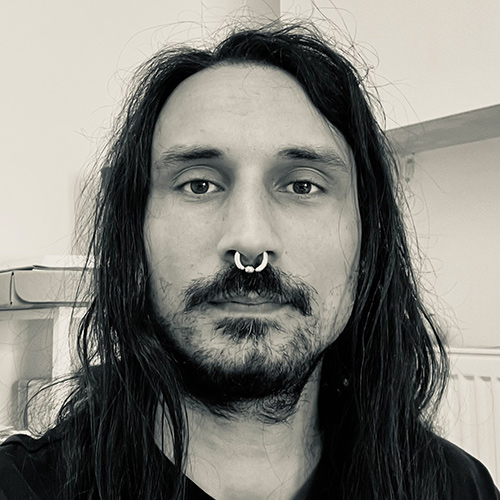 Jaka Vatovec (1989, Postojna) graduated in Painting from the Academy of Fine Arts and Design in Ljubljana in 2016. He is mainly active in the fields of painting and drawing and has published several artist books and fanzines. His work is influenced by the visual content of fringe subcultures and B-grade films, especially horror films produced in Europe in the 1970s. Thematically, he explores the notion of mental health and the way it is understood, as well as death and our relationship to it – both in physical and symbolic form. The latter is often interwoven with themes of religion and obscure spiritual and magical and/or occult ideas. He has shown work in many solo and group exhibitions at home and abroad, including: inhale exhale, Kulturni dom Nova Gorica, Nova Gorica (2023); Army and the City, Hiša Kulture Pivka, Pivka (2020); Weeds, Hiša Kulture Pivka, Pivka (2020); Baby Shower, Stiege 13, Vienna, Austria (2019); Post-Christmas Depression, P74 Gallery, Ljubljana (2017); SAMO group exhibition of prints, KAPSULA, Ljubljana (2019); Off the Hook, Neurotitan Gallery, Berlin, Germany (2017); Off the Hook, UGM, Maribor (2016), Motivi di famiglia / Family reasons, Villa di Toppo Florio, Udine, Italy (2014); EXHIBITION Nr. 23, CAC Landskrona, Sweden (2014). He has participated in the artist book fairs and art editions Blind Date Convention (P74 Gallery) and Caffeine Hours (Indigo Festival). (Foto: personal archive)
Jaka Vatovec (1989, Postojna) graduated in Painting from the Academy of Fine Arts and Design in Ljubljana in 2016. He is mainly active in the fields of painting and drawing and has published several artist books and fanzines. His work is influenced by the visual content of fringe subcultures and B-grade films, especially horror films produced in Europe in the 1970s. Thematically, he explores the notion of mental health and the way it is understood, as well as death and our relationship to it – both in physical and symbolic form. The latter is often interwoven with themes of religion and obscure spiritual and magical and/or occult ideas. He has shown work in many solo and group exhibitions at home and abroad, including: inhale exhale, Kulturni dom Nova Gorica, Nova Gorica (2023); Army and the City, Hiša Kulture Pivka, Pivka (2020); Weeds, Hiša Kulture Pivka, Pivka (2020); Baby Shower, Stiege 13, Vienna, Austria (2019); Post-Christmas Depression, P74 Gallery, Ljubljana (2017); SAMO group exhibition of prints, KAPSULA, Ljubljana (2019); Off the Hook, Neurotitan Gallery, Berlin, Germany (2017); Off the Hook, UGM, Maribor (2016), Motivi di famiglia / Family reasons, Villa di Toppo Florio, Udine, Italy (2014); EXHIBITION Nr. 23, CAC Landskrona, Sweden (2014). He has participated in the artist book fairs and art editions Blind Date Convention (P74 Gallery) and Caffeine Hours (Indigo Festival). (Foto: personal archive)
COLOPHON
Artist: Jaka Vatovec
Curators: Tia Čiček, Lara Plavčak (Škuc); Vesna Bukovec, Anabel Černohorski, Ana Grobler, Sebastian Krawczyk (Alkatraz)
Video editor: Olga Michalik
Slovene proofreading: Neja Berlič, Inge Pangos
English translation: Ana Makuc, Arven Šakti Kralj
Design (Škuc): Lea Jelenko
Co-production: Škuc Gallery, KUD Mreža, SCCA-Ljubljana
Supported by: Ministry of Culture of the Republic of Slovenia and City of Ljubljana – Department for Culture
Thanks: P74 Gallery
![]()
![]()
![]()
![]()
![]()
![]()

